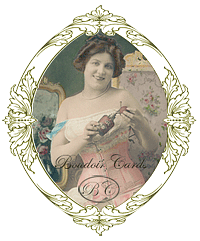Mata Hari
(Margaretha Geertruida Zelle)
* August 7th 1876, Leeuwarden (Netherlands)
† October 15th 1917, Vincennes (France)
Mata Hari was born as Margaretha Geertruida Zelle in the northern Netherlands. For a few years she was one of the most glorified dancing artists of the Belle Epoque, shining up and disappearing like a comet and mystified by an early tragic death. The story of her life as an exotic dancer and unfortunate spy during WW I is one of the most fascinating of all Belle Epoque stars.
After a protected childhood, Margaretha suffered a difficult adolescence after the divorce of her parents. She was separated from her admiring father, a once wealthy hat-maker. Her mother passed away two years later and the young M'greet, how she was called then, was raised at an uncle's house. Still having no job at age nineteen, Margaretha married in an act of desparation the Dutch military officer Rudolf (John) MacLeod (1856-1928), who was 20 years older than her. Due to his military-service in the Dutch-East-Indian colonies, they left the Netherlands in 1897 and lived for several years in Java and later Sumatra. Margaretha gave birth to two children, Norman (1896-1899) and Luise-Jeanne, called Non (1898-1919). Very soon Margaretha felt more and more unhappy and dissatisfied in her relationship due to the "rough" behaviour of her husband, who had alcohol-issues and visited prostitutes. The tragic death of her son Norman in 1899 contributed to the failure of their marriage. In 1900 Rudolf MacLeod retired from military-service and they returned to Europe in 1902, soon living separately. The marriage got eventually divorced in 1906, officially due to circulating nude photos of Mata Hari.
In 1903 Margaretha MacLeod moved to Paris to become a model, but without any contracts and success she had to return to the Netherlands. One year later, after creating exotic Asian dresses and dances, she started another attempt in Paris and performed in small clubs and salons, i.e. at Madame Kiréevsky's. Soon she acquired the reputation of an exotic bayadère artist, and the sensual and erotic character of her expressive dances contributed to her increasing popularity. With further support by Emile Guimet, a wealthy art collector and amateur orientalist, her official debut as a dancer took place in front of about 300 spectators of Paris' high society at the private Musée Guimet in Paris on March 13th 1905. The public and the critics were enthusiastic. From now on she changed her name to Mata Hari (Javanese for "Eye of Dawn", or "Eye of Day") and created a very imaginative Asian alter ego as an indigenious Indian bayadère. The people of the Belle Epoque were enthusiastic for Oriental exoticism and consumed her stories and admired her performances uncritically. Concerning her educational and biographical life career she frequently changed details and presented different stories about her "exotic" life in Far East. Because of the hype about orientalism and lack of reliable knowledge, she didn't have to be concerned, that people would doubt her stories. These early years in Paris were also her most successful time as an artist, and she was frequently seen on various Parisian variety and theatre stages like the Olympia, the Trocadéro or the Folies Bergère. The famous designer Erté created his first theatrical costume for Mata Hari in 1913 for a play at the Folies Bergère called "Le Minaret". She also presented her dances at other European metropolises like Madrid, Vienna and Berlin. Further highlights of her career were her dancing performances at the Opera of Monte Carlo and the Scala at Milan in Italy. Mata Hari's ambition was, to achieve reputation as a legitimate opera and ballet dancer, despite never having a professional training. Thus her dream to join Serge Diaghilev’s famous Russian Ballet to perform "Salome" never came true. Nevertheless numerous affairs all over Europe with wealthy people of society, politicians and military-officers allowed her a life in luxury and glory. On the other side, being not smart with budgeting, she had times when she had to make a living as a (high class) Courtesan.
Unfortunately in 1914 Mata Hari had to cancel her new six-month contract with the Metropol-Theatre in Berlin due to the begin of World War I in July. In return the theatre held back all her precious furs and jewelry. She had to return to the Netherlands and lived in The Hague. Except two single performances, the wartime left no chance for theatre contracts in the Netherlands. With the end of the Belle Epoque Mata Hari was faced with her fading career and glory and had to deal with financial shortcomings. She got involved in dubious relationships and connections with politicians, army officers and people from secret services. In a very naive, dilettantish and sometimes pretentious way she offered, or got recruited (?), to work as a spy, first for the German (Department IIIb) and later for the French secret service (Deuxième Bureau, Captain Ladoux), acting like a double agent. Due to informations about her role as a spy for the Germans, reported by the British intelligence servive MI5 to the Deuxième Bureau in 1916, the French intelligence surveilled all of her actions meticulously, while she was travelling to France, Spain and Belgium. Finally she was arrested at Paris in February 1917 by the French police and imprisoned at Saint Lazare without any official information to the public. There she had to undergo long lasting interrogations by the chief-prosecutor Captain Pierre Bouchardon. As a result of Bouchardon's prejudiced investigations, a military court declared her guilty of treason in July 1917. None of her former friends took any action in defense of her, and the court neglected evidence which could have saved her. Obviously Mata Hari and her already 74 years old attorney Edouard Clunet, inexperienced in military trials, didn't realize the serious danger of the situation. Inevitably this led to her tragic end by execution at age 41 in Vincennes, France, on October 15th 1917.
Because no one raised a claim for her corpse, the body was transferred to the Medical Department of the Sorbonne University at Paris for autopsy. There is dubious speculation, that Mata Hari's preserved head was kept at the Anatomical Museum (Musée d’Anatomie Delmas-Orfila-Rouvière), where it got lost (stolen?). Actually there is no evidence for this story. Her belongings were put on auction to pay the court costs. Jeanne, her daughter, was left nothing. The French were quite thorough in destroying Mata Hari's existence without leaving any trace.
Nevertheless her early death promoted her mystery and made Mata Hari one of the best known women of the Belle Epoque, despite her artistically rather short career. More than 250 books and several movies, one with Greta Garbo as Mata Hari (1931), created a myth beyond Margaretha Zelle and made her alter ego Mata Hari immortal. By the lack of reliable information and due to writers, whose imagination equalled Mata Hari's own fantasy, it was very difficult to distinguish the truth from fiction and fairytales about her life. Only in recent years, there were several publications by authors who relied only on facts. But even the original sources, like autobiographies by Captain Georges Ladoux and others of Mata Hari's contemporaries, or documents by German military officers have to be judged very cautiously because of their very subjectice character.
It was and it is still a lot of controversial speculation and discussion by numerous writers and historians about her role as a spy with the German code name "H 21". Different sources still report sometimes contradictory interpretations of how Margaretha Zelle got into contact with the German intelligence, with the head of the Department IIIb, Colonel Walter Nicolai, or Major Roepell and Captain Hoffmann. Some sources state, that Mata Hari received a special espionage training by Major Roepell and Dr. Elsbeth Schragmüller ("Fräulein Doktor", "Mademoiselle Docteur") at Frankfurt for several days in March 1916(!). On the other side she was already under suspicion of espionage by the British MI5 in 1915. The role of the German Military Attaché in Madrid, Major Arnold Kalle and the German Consul General in Antwerpen, Carl Hubert Cremer, remains still very dubious.
Besides all, it seems most reasonable, that Mata Hari's intentions in offering her collaboration for espionage resulted from her ambition, of still being an important person even in wartime, and improving her financial situation to keep up her standards of living. Nothing in her biography gives hints, that she was interested in politics.
Out of a plenty of books and biographies about her fascinating life we chose only these books for the bibliography, which seem to be most reliable. From all the authors, Sam Waagenaar is the one with the most primary sources, having talked to relatives, contemporary witnesses and her long-term maid Anna Lintjens. From Anna Lintjens he obtained Mata Hari's diaries and notebooks and he had access to special files about her interrogations and trial. Fortunately Waagenaar (in the revised second edition of his biography; 1976) and some other authors of recent publications (i.e. Howe, Schirmann, Turbergue and Wheelwright) were able to use further, previously not available material, when the French government provided more files on Mata Hari. The complete documents about her trial were recently published online by the Ministère des armées - Memoires des hommes. It contains 1275 pages in French language, including personal documents and letters of Mata Hari.
At her hometown Leeuwarden in the north of the Netherlands, there is a huge statue at the Korfmakerspijp, near the house in which she grew up. The Fries-Museum at Leeuwarden shows a permanent Mata-Hari-Exhibition and established a Mata-Hari-Foundation. They show Mata Hari's unique scrap-books and some years ago they were lucky to get one of Mata Hari's famous dancing dresses.
The myth of Mata Hari is an everlasting fascination, founded on the mystery about her life, exoticism, the suspence of espionage and her tragic death. Her name is used in promotion for all kinds of things like i.e. hotels, resorts, bars, liquors, numerous shops and all kinds of advertisement.
Mata Hari's postcards with portraits from a few photo-sessions, mostly photographed by Lucien Walery and Paul Boyer, are rare collector's items. Original postcards or photo prints are difficult to find and usually only available for ridiculously high prices at online auctions.
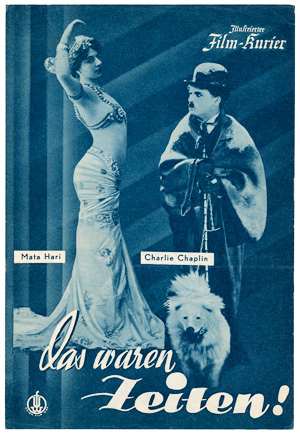
Illustrierter Filmkurier 1045 - Das waren Zeiten
Mata Hari - Charlie Chaplin
(Union Film Wien - photographers unknown)

|
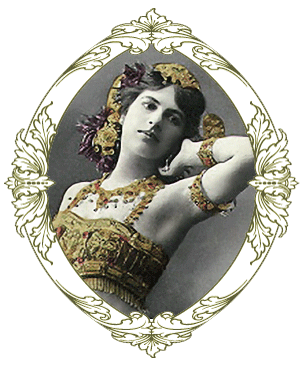
Selected Bibliography:
-
-
-
-
-
-
-
-
-
-
Turbergue, Jean-Pierre (Ed.)
Mata Hari: Le Dossier Secret du Conseil de Guerre
Éditions Italiques, 2001
-
-
-
Millar, Ronald
Mata Hari
Heron Books, 1970
-
-
Gómez Carrillo, Enriqu
Mata Hari. Das Geheimnis ihres Lebens
und ihres Todes
C. Weller & Co, 1927
Web-References:
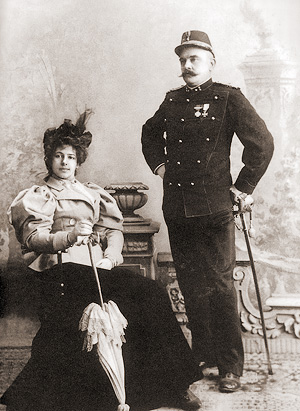
Margaretha Zelle & Rudolf MacLeod - 1897
(Photographer unknown)
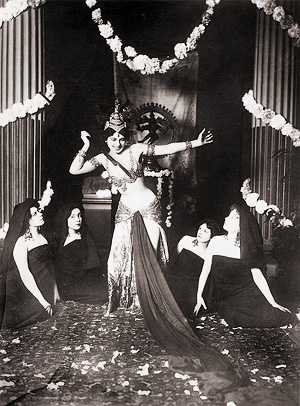
Mata Hari at Musée Guimet March 13th 1905
(Photographer unknown)
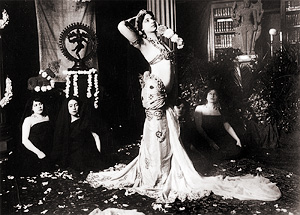
Mata Hari at Musée Guimet March 13th 1905
(Photographer unknown)
Mata Hari on Youtube:
Mata Hari - Movies
-
1920: Mata Hari
(Germany; Director: Ludwig Wolff)
with Asta Nielsen
-
1927: Mata Hari, die rote Tänzerin
(Germany; Director Friedrich Fehér)
with Magda Sonja
-
1931: Mata Hari
(USA; Director George Fitzmaurice)
with Greta Garbo
-
1964: Mata-Hari - Agent H.21
(France/Italy; Director Jean-Louis Richard)
with Jeanne Moreau
-
1985: Mata Hari
(USA; Director: Curtis Harrington)
with Sylvia Kristel
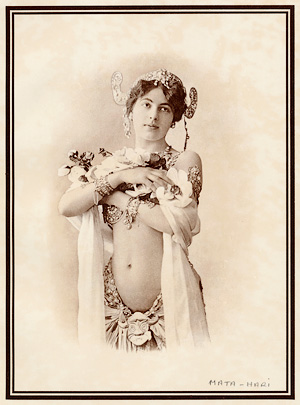
Print from unknown source
(Photographer Gaston Menier or Paul Boyer)
|
